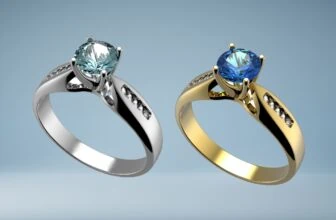
Table of Contents
Although purple has been a color used in jewelry since ancient times, there aren’t many purple gemstones out there. Compared to other colors such as blue, red, and green which have hundreds of gemstone varieties to choose from, the number of purple gemstones is quite small.
Purple is often connected to royalty and nobility, power and wealth. It is a luxurious color and depicts prestige and class. Purple jewelry adds a touch of sophistication and elegance and is an eye-catching color.
There are many varieties of purple including violet, lilac, lavender, mauve, mulberry, and wine. To help you choose your stone and shade, here are our top 12 purple gemstones for jewelry.
Purple Gemstone list
1. Purple Diamonds
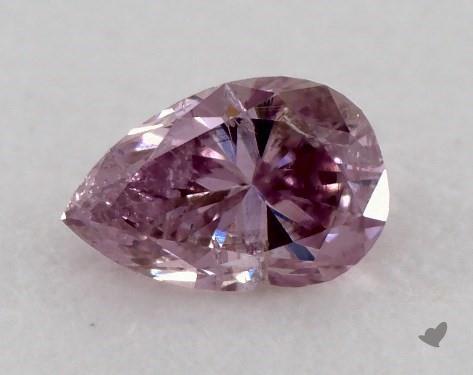
Purple diamonds are created when there is a high amount of hydrogen present during the diamond’s formation. These spectacular stones are rare and expensive, especially if the stone is vivid and saturated in color. However, enhanced or synthetic alternatives are relatively much more affordable.
Purple diamonds are known by a variety of nicknames, including Lilac, Orchid, Lavender, Grape, and Plum Diamonds which describe the color of the stone. High-quality purple diamonds are generally sought after by collectors and diamond enthusiasts or those with a penchant for exclusive jewelry.
2. Amethyst

Amethysts are the most well-known purple gemstone. In the past, amethysts were considered a cardinal gemstone (gemstones considered precious above all others) and on equal par with diamonds, sapphires, rubies, and emeralds. However, when large deposits were found in Brazil, the value of amethysts dropped making it an affordable gemstone that suits almost all budgets.
Amethysts come in all shades of purple, with those displaying the deepest purple hues considered the best. Amethysts are durable enough for use in all types of jewelry (7 Mohs) but require reasonable care to maintain their luster and color.
They can easily get scratched and due to their brittleness, can chip or crack when exposed to rough wear. The color of amethysts can also fade if exposed to direct light for too long. However, if maintained well, amethyst jewelry can last a lifetime.
3. Purple Chalcedony

Features:
- Quite durable
- Vitreous – waxy luster
- Relatively affordable
Purple chalcedony comes in beautiful shades of purple from light lilac to dark purple. Purple chalcedony is usually translucent to opaque, with a vitreous to waxy luster. It has a very appealing look with a rich natural color.
Chalcedony has a microcrystalline structure without crystal formations within it. As a result, it is compact, contains no cleavage, and is very durable. Purple chalcedony is a tough stone with medium hardness (6.5 to 7 Mohs).
Most chalcedony is cut en cabochon or used in beautiful carvings and engravings. However, sometimes these stones are faceted to add more depth and light play to the piece of jewelry. Chalcedony jewelry is ideal for bohemian and ethnic jewelry designs.
4. Purple Spinel

Purple spinel comes in a variety of shades, with lilac and mauve considered more attractive. However, it is not as valuable or sought-after as red and blue spinel. Purple spinel is relatively affordable and a durable gemstone (Mohs 8) suited for everyday wear.
It is a brilliant gemstone and due to this, is often cut into faceted gemstone shapes to enhance its brilliance. Purple spinel has been synthesized but it is rarely enhanced or treated, meaning that the color you see in a purple spinel stone is likely to be natural.
5. Iolite
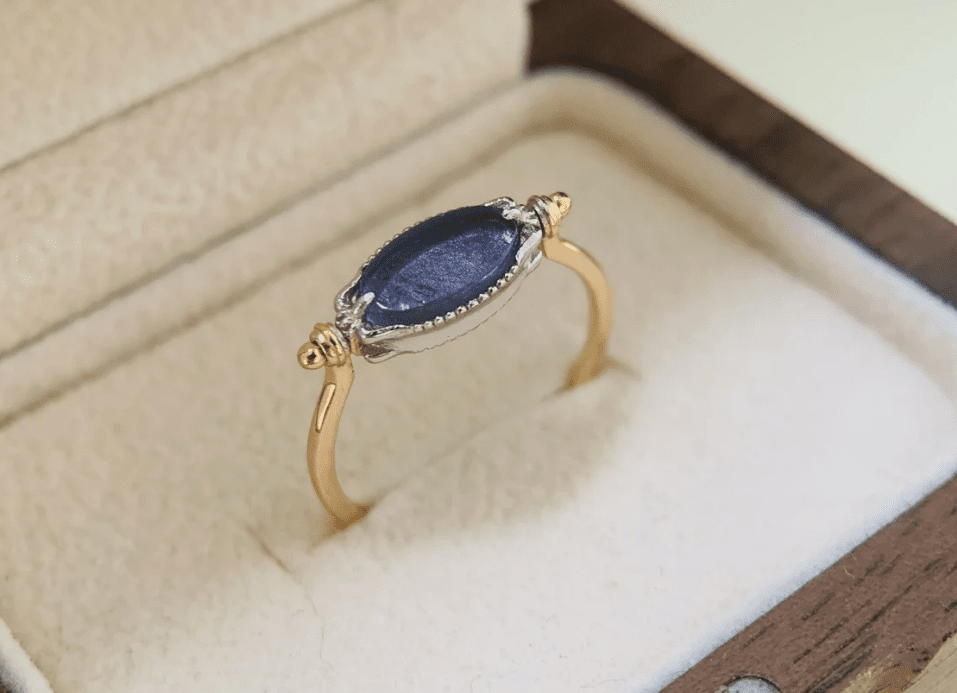
Although iolites are highly sought-after gemstones, they are quite stunning and can rival the beauty of more expensive blue stones such as sapphire or tanzanite. It is a highly brilliant stone that occurs in blue-purple shades, but due to its abundance, it is not highly valued. Iolite has distinct cleavage making it susceptible to chipping or cracking if struck with force.
However, it has fairly good hardness (7 to 7.5 Mohs) and can be used in almost all types of jewelry. When mounted in rings, it is best to set iolite in protective settings such as a bezel or halo. Beautifully faceted iolite sparkles with eye-catching brilliance. Iolite is perfect for jewelry where it is able to catch the light, such as on a ring or in dangling earrings.
6. Purple Jade

Most people think of green when they say the word jade, but jade occurs in a range of colors, including beautiful purple shades. There are two varieties of jade: nephrite and jadeite. Nephrite is more abundant and less expensive, while jadeite is considered of better quality and is pricier.
Purple jade is fairly soft (6 Mohs) but is very tough due to its compact composition. Purple jade is found in translucent to opaque varieties and has a smooth, waxy luster. Most jade is often cut into cabochons or various special smooth cuts or carved. Faceting jade is less common but can give the gemstone added depth.
7. Purple Sapphire
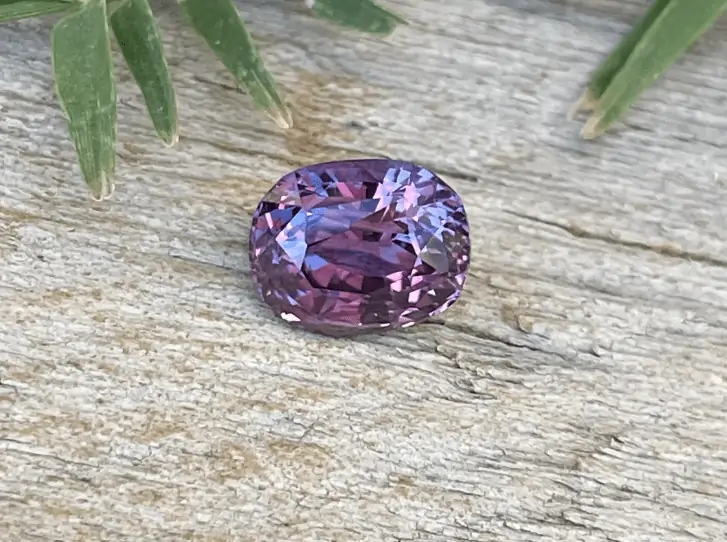
Say sapphire and we think of a vivid blue gemstone. But there is such a thing as purple sapphire which is rarer and as beautiful as its blue counterparts. This color occurs because traces of elements such as chromium is present during the sapphire’s formation.
Many people sometimes confuse purple sapphires for amethysts, but purple sapphires are a more durable and hard (Mohs 9) gemstone, second only to diamonds but with better toughness. They are extremely resistant to breakage and chipping.
While most other sapphires on the market are heat treated to enhance color and clarity, purple sapphires are generally not treated because they have very good natural coloring. Because of their brilliance and durability, these sapphires are an excellent choice if you want a purple gemstone for an everyday piece of jewelry, such as an engagement ring.
8. Purple Fluorite

Fluorite is a very popular variety of gemstones among collectors but is not commonly used in jewelry due to its low durability. The quintessential fluorite color is purple, but it occurs in every color imaginable. While most purple fluorite occurs in a single color, there is a purple and white banded variety known as Blue John.
High-quality purple fluorite should have very good transparency and be eye-clean. Fluorite has a beautiful vitreous luster and can be cut into most standard gemstone shapes. However, fluorite is very soft (Mohs 4) and has distinct cleavage.
It is not suitable for most types of jewelry, especially those that are likely to have high exposure. However, it can be used in jewelry such as pendants and earrings.
9. Purple Kunzite

Kunzite is a little-known beautiful gemstone that occurs in pink to purple shades. The gem was first discovered in the USA but today most kunzite comes from Pakistan and Afghanistan. Most purple kunzite is quite light in color but some stones can have a vivid and intense hue.
Kunzite can also exhibit pleochroism, which refers to its ability to exhibit two colors at the same time depending on the angle it is viewed from. Typically, the two colors are pink and purple or colorless.
Kunzite is also generally free of inclusions and has very good transparency. You can find kunzite in a range of fancy shapes, although smooth polished cabochons are also common.
Most kunzite on the market is free of treatments or enhancements. Kunzite is a fairly durable stone (6.5 to 7 Mohs) that can be used for most types of jewelry. However, as it has very distinct cleavage, it is prone to breakage and needs to be protected from impact and blows. Kunzite remains a very affordable stone and because it is found in large sizes, it is perfect for large statement jewelry.
10. Purple Tourmaline

Purple tourmaline is not the most popular tourmaline color but is beautiful when set in jewelry. They come in a range of purple shades and can be quite affordable. All colored tourmaline exhibits some form of pleochroism. This makes tourmaline a dynamic and vibrant gemstone for jewelry, especially when viewed from different angles under lights.
Most purple tourmalines are faceted to enhance the stone’s brilliance and pleochroism (if noticeable). Purple tourmaline has good durability (7 to 7.5 Mohs) and with reasonable care can last a very long time.
Heat treatment is commonly carried out on tourmalines to enhance their color, however, your vendor should let you know if such treatments have been done on your stone.
11. Sugilite

Sugilite was initially discovered in Japan and is categorized as a rare gemstone. Small deposits of sugilite have been found in other regions but these are not abundant. As a result, it is not a mainstream gemstone and there aren’t many options when it comes to sugilite jewelry.
Sugilite is found in faint pink-purple varieties to dark blue-purple. However, the most valuable and sought-after sugilite color is an evenly saturated vivid purple hue. Sugilite is often opaque to translucent and most contain dark veins or patches that form interesting patterns on its surface.
It is commonly cut en cabochon or carved into intricate and beautiful designs, although translucent sugilite can be faceted for added depth and light play. Sugilite is rarely enhanced or treated. It is not a very durable gemstone (5.5 to 6.5 Mohs) and can easily get damaged.
12. Purple Jasper
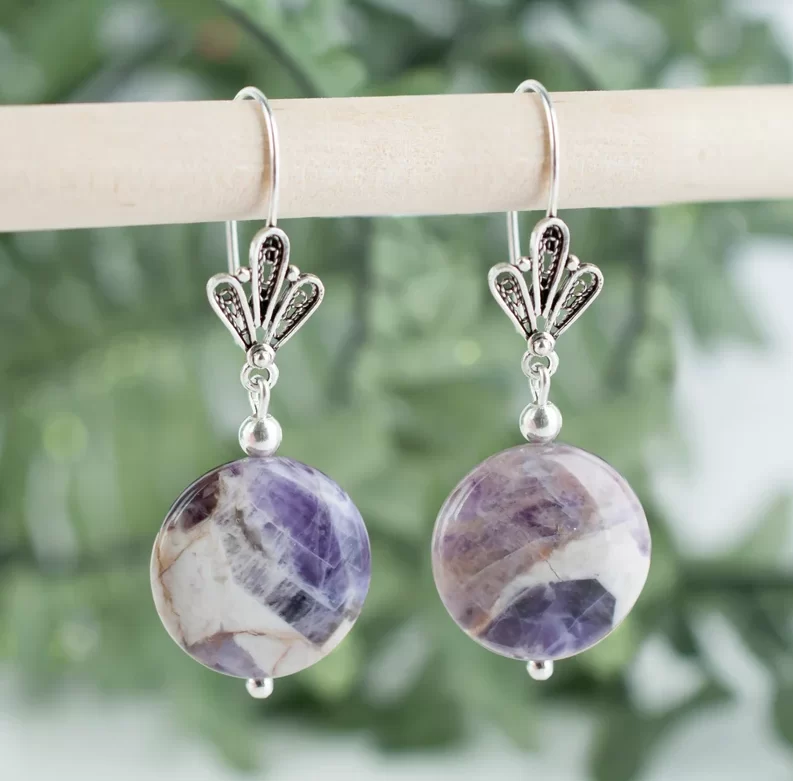
Jasper is commonly red, but it can also be found in purple shades. It is a variety of chalcedony, a type of quartz. Jasper often has interesting matrix inclusions and patterns that add character to the stone and are quite desirable. Most jasper is translucent to opaque in clarity and is often cut en cabochon or carved. Jasper is rarely faceted.
With a hardness of 6.5 to 7 on the Mohs scale and very good toughness due to its compact nature, jasper jewelry can last a very long time without damage. As it is relatively affordable, it is an ideal gemstone for costume jewelry and statement pieces.
13. Charoite

Charoite is a rare silicate mineral that is found only in Russia. It is known for its beautiful swirling patterns of lavender, purple, and white colors. It was first discovered in the 1940s, but it was not until the 1970s that it became popular as a gemstone. Charoite is believed to have healing properties and is often used in meditation and energy work.
It is also a popular stone for jewelry making due to its unique appearance. Despite being a relatively new gemstone, charoite has gained a devoted following among collectors and enthusiasts.
Charoite is a relatively soft mineral with a hardness of around 5 to 6 on the Mohs scale, which is a measure of a mineral’s resistance to scratching. This makes it softer than many other gemstones, such as diamonds and sapphires, which have higher hardness ratings. As a result, care must be taken when handling and wearing charoite jewelry to avoid scratching or damaging the stone.
14. Purple Agate
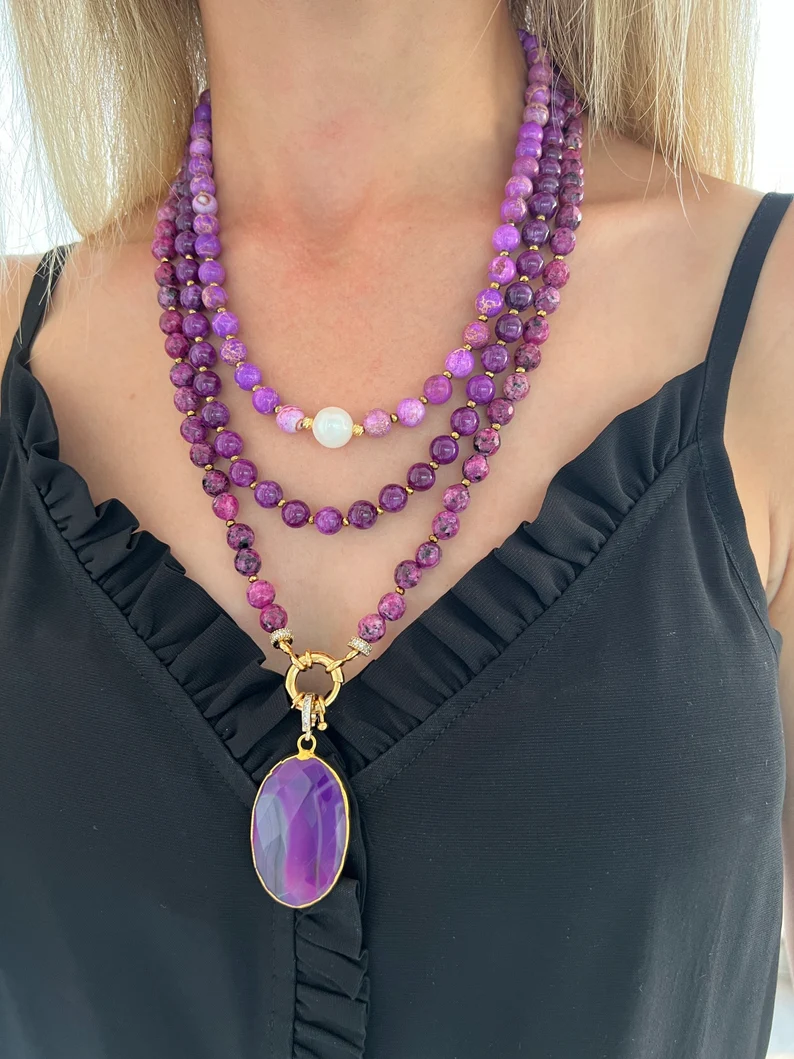
Purple agate is a variety of chalcedony with purple-colored bands or stripes. It is a relatively hard mineral with a hardness of around 6.5 to 7 on the Mohs scale, which makes it suitable for use in jewelry and decorative objects. Agate has a long history of use in human culture, with examples dating back to ancient Egypt and Greece.
Purple agate is believed to have a calming and balancing effect on the mind and body, and is sometimes used in crystal healing and meditation practices. Unique to agate is its formation in concentric bands and layers, creating a distinctive pattern that is different for each individual stone.
15. Purple Lepidolite
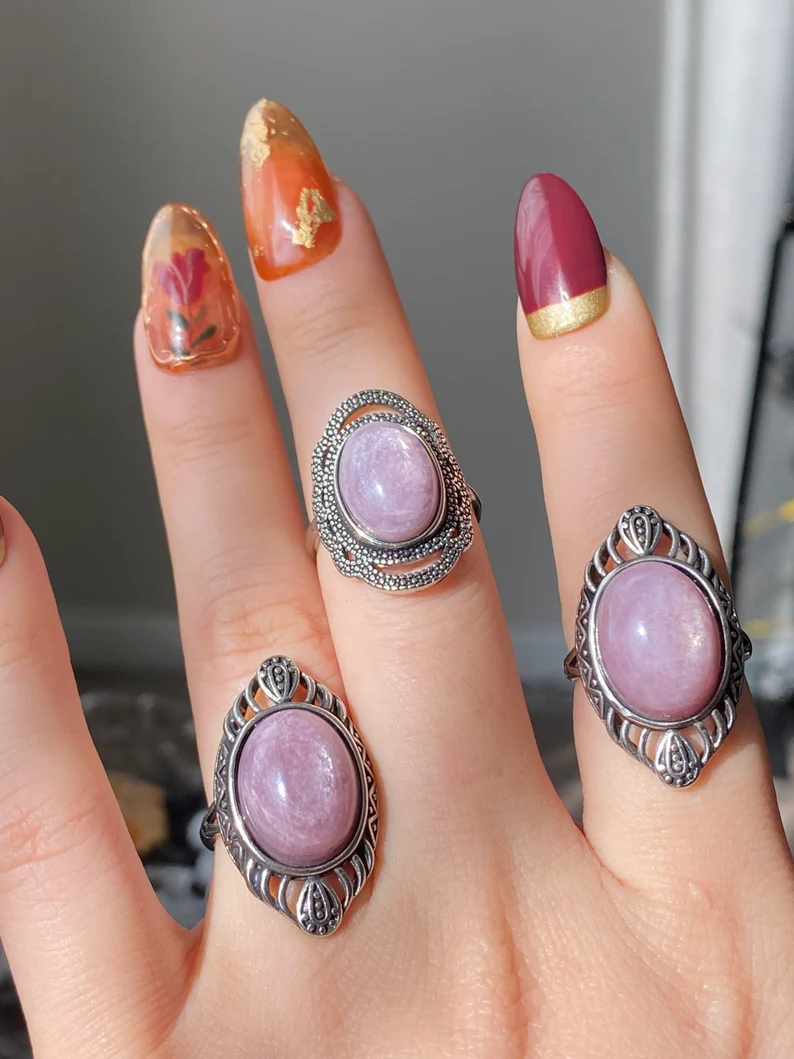
Purple lepidolite is a mineral that is commonly found in shades of purple and lilac. It is a relatively soft mineral, with a hardness of around 2.5 to 3 on the Mohs scale, which makes it unsuitable for use in most types of jewelry. However, it has been used in the past as a source of lithium, and is sometimes used in the production of glass and ceramics.
Lepidolite has a unique property of containing small amounts of the element rubidium, which gives it a distinctive pink or purple color. It also contains other minerals such as mica and quartz, which create a glittery, sparkly effect when the stone is polished or cut.
16. Purple Scapolite

Purple scapolite has a hardness of 5.5-6 on the Mohs scale and is commonly found in shades of purple, pink, and yellow. The mineral was first discovered in the early 19th century in Canada and named after the Greek word “skapos” meaning “shaft” due to its elongated crystal shape.
In terms of unique information, scapolite is often used in metaphysical practices as it is believed to promote clarity, self-awareness, and communication. It is also used in jewelry making due to its attractive appearance and durability. The gemstone is typically faceted or polished into beads to be used in necklaces, bracelets, and earrings.
17. Purple Garnet

Purple garnet has a long history, with evidence of its use dating back to ancient Egypt. It is a unique gemstone because of its uncommon color and rarity. It is also sometimes called “grape garnet” due to its deep, rich purple color.
Purple garnet is often used in jewelry, particularly in earrings and pendants, and is believed to have metaphysical properties that enhance creativity and self-expression. It comes in shades of violet, purple, and pink and is a relatively hard gemstone with a Mohs hardness of 6.5 to 7.5.
18. Purple Zircon

Purple zircon is a rare and highly valued gemstone that belongs to the group of naturally occurring minerals called nesosilicates. It has a hardness of 6.5 to 7.5 on the Mohs scale and is known for its exceptional brilliance and fire.
The history of purple zircon dates back to ancient times, where it was believed to have healing properties and was often used as an amulet. It is a unique gemstone due to its ability to exhibit different colors depending on the angle of light.
Purple zircon is often used in jewelry, including rings, earrings, and pendants, and is a popular choice for those looking for an alternative to traditional purple gemstones like amethyst or sapphire.
19. Purple Apatite
Apatite has been known since ancient times and has been used for a variety of purposes, including as a source of phosphorus for fertilizers and as a gemstone. It occurs in a range of geological settings, including igneous, sedimentary, and metamorphic rocks.
It can also contain trace amounts of rare earth elements and radioactive elements such as uranium and thorium, which can make it useful for geochronology and other scientific studies.
Purple apatite is not as commonly used in jewelry as other gemstones, but it can be faceted and polished to make attractive and unique pieces. Its color ranges from pale lilac to deep violet, and it can be found in a variety of shapes and sizes. It is also sometimes used in beaded jewelry designs.
20. Tanzanite

Tanzanite is a rare blue-violet gemstone that was first discovered in Tanzania in 1967. It is a type of zoisite mineral and gets its blue color from the presence of vanadium. It has a hardness of 6.5 to 7 on the Mohs scale, making it a relatively hard gemstone, but it is also somewhat brittle, and must be handled carefully.
Tanzanite is a popular gemstone choice due to its beautiful color and relative rarity. It is often cut into faceted shapes to showcase its brilliance and color. It is commonly used in rings, earrings, necklaces, and bracelets. It is also sometimes used as a center stone in engagement rings.
Due to its relative softness and brittle nature, tanzanite should be worn with care and not exposed to harsh chemicals or extreme temperatures.
21. Purple Dumortierite
Purple Dumortierite is a rare violet-blue gemstone that was named after the French paleontologist Eugene Dumortier, who first described it in 1881. It is composed of aluminum, silicon, and oxygen, with traces of iron, magnesium, and other minerals giving it its unique color.
The hardness of Purple Dumortierite ranges from 7 to 8 on the Mohs scale, which makes it a durable and suitable gemstone for use in jewelry. However, it is not commonly used in jewelry due to its scarcity and high cost.
Purple Dumortierite is commonly cut into cabochons, faceted gems, and beads. Its stunning violet-blue color is often paired with sterling silver or white gold to create elegant and sophisticated pieces. Due to its rarity and cost, Purple Dumortierite is often used in high-end jewelry designs.
22. Purple Howlite

Purple howlite is a naturally occurring mineral that is often dyed to achieve its purple color. It has a hardness of 3.5 on the Mohs scale and is commonly used in jewelry as beads, cabochons, and other decorative purposes. Its unique marbled texture makes it a popular choice for bohemian and hippie-inspired jewelry designs.
It was first discovered in 1868 in Nova Scotia, Canada. While it is not a particularly rare gemstone, its low cost and durability make it a popular choice for affordable jewelry designs.
23. Purple Prehnite
Purple prehnite is a type of prehnite mineral that exhibits a lovely violet color. It is a relatively rare gemstone that is often used in jewelry for its unique hue and attractive appearance. Prehnite was first discovered in the late 1700s in South Africa and was named after Dutch mineralogist Colonel Hendrik von Prehn.
Purple prehnite is often found in association with other minerals, such as quartz and epidote, and can have a translucent or opaque appearance. Its unique purple color and natural striations make it a popular choice among gemstone collectors and enthusiasts. Due to its relative rarity, purple prehnite is often used in high-end jewelry designs.
24. Lavender Jade
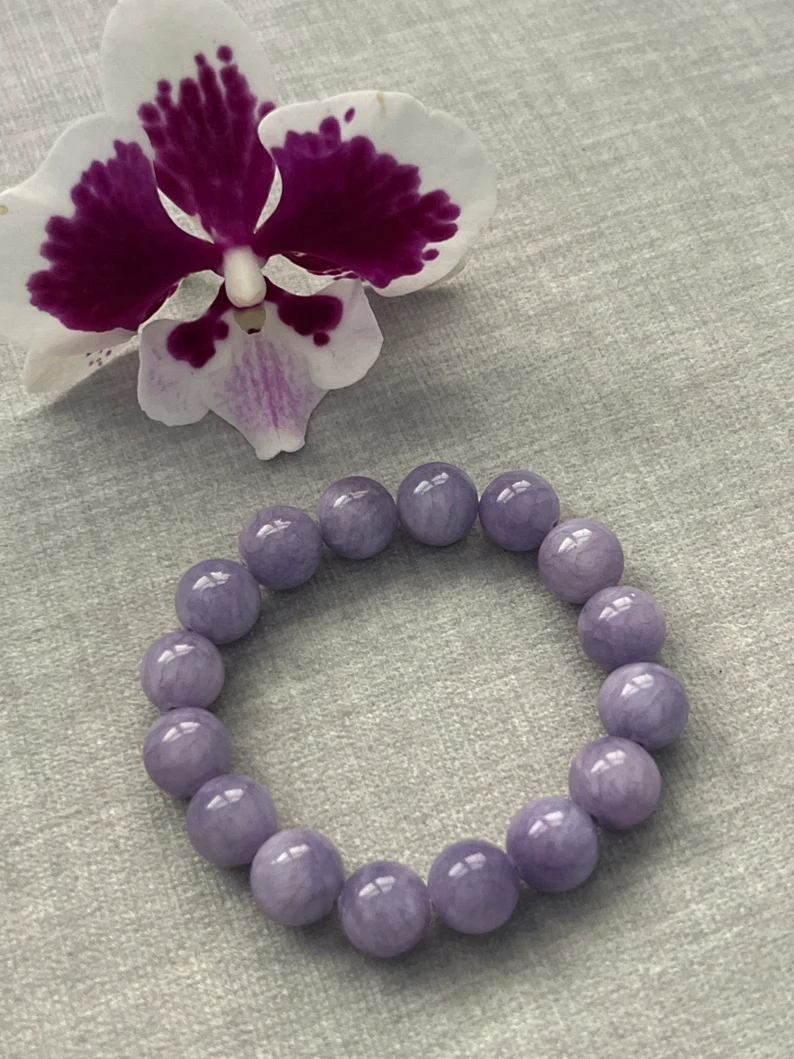
Lavender jade is a relatively new discovery in the world of gemstones, with the first deposit being found in the foothills of the Himalayan Mountains in 2008. It has a hardness of 6 to 7 on the Mohs scale, which makes it a durable and suitable gemstone for use in jewelry. It is often found in association with other minerals, such as serpentine and garnet.
In jewelry, lavender jade is commonly cut into cabochons, beads, and other decorative shapes. Its unique and delicate color makes it a popular choice for feminine and delicate designs, and it is often used in necklaces, earrings, and bracelets.
25. Purple Beryl
Purple beryl, also known as amethyst beryl or red beryl, is a rare variety of beryl that exhibits a stunning purple-to-red color. It is one of the rarest gemstones in the world, with only a few known deposits in the United States, namely in the Wah Wah Mountains of Utah and the Black Range of New Mexico.
Purple beryl has a hardness of 7.5 to 8 on the Mohs scale, which makes it very durable and ideal for use in jewelry. Its unique color and rarity make it a highly sought-after gemstone for collectors and enthusiasts. Due to its scarcity, purple beryl is often used in very high-end jewelry designs and can fetch very high prices at auctions.
Which Purple Gemstone Should I Choose?
For Engagement Rings
When it comes to engagement rings, durability, and hardness are important factors to consider in a gemstone. Some of the purple gemstones that are suitable for engagement rings include:
- Amethyst: This is a popular and affordable purple gemstone that has a hardness of 7 on the Mohs scale, making it durable enough for everyday wear.
- Tanzanite: This gemstone is rare and highly valued for its deep violet-blue color. It has a hardness of 6 to 7 on the Mohs scale and can be used in engagement rings with protective settings.
- Purple sapphire: This gemstone has a rich and intense purple color and a hardness of 9 on the Mohs scale, making it an excellent choice for an engagement ring.
- Purple spinel: This gemstone has a hardness of 8 on the Mohs scale and is known for its brilliance and durability.
- Purple diamond: Diamonds that have a strong purple hue are rare and highly valued. They have a hardness of 10 on the Mohs scale, making them the hardest gemstone and ideal for everyday wear.
Ultimately, the choice of gemstone for an engagement ring is a personal one and should be based on factors such as personal taste, budget, and lifestyle.
For Costume and Fashion Jewelry
There are many purple gemstones that are suitable for costume and fashion jewelry, including:
- Purple howlite: This is a popular affordable gemstone that is often dyed to achieve a deep purple color. It is a relatively soft gemstone, making it ideal for use in costume jewelry.
- Purple agate: This gemstone is known for its wide range of purple shades and patterns. It is durable and can be used in a variety of jewelry styles.
- Lavender quartz: This gemstone has a soft and delicate purple hue, making it a popular choice for feminine and delicate fashion jewelry designs.
- Charoite: This gemstone has a unique swirling pattern of purple, white, and black. It is relatively soft and suitable for use in fashion jewelry.
- Fluorite: This gemstone comes in a variety of purple shades and is known for its unique and intricate patterns. It has a hardness of 4 on the Mohs scale.
Soft Purple Gemstones
Soft gemstones are those that have a hardness rating of less than 7 on the Mohs scale. These gemstones can be easily scratched or damaged with regular wear, so they are not recommended for jewelry that is subjected to daily wear and tear, such as engagement rings. However, soft gemstones can be used in a variety of jewelry types, including:
- Earrings: Soft gemstones can be used to create beautiful and delicate earrings that are not subjected to heavy wear and tear. Examples of soft purple gemstones that can be used in earrings include amethyst, purple fluorite, and charoite.
- Pendants: Soft gemstones can also be used to create beautiful and unique pendants. Pendants are not subjected to as much wear and tear as rings or bracelets, so soft gemstones can be used to create intricate and detailed designs. Examples of soft purple gemstones that can be used in pendants include lavender quartz and purple howlite.
- Brooches: Brooches are another type of jewelry that can be created using soft gemstones. Soft purple gemstones such as purple agate and purple jade can be used to create intricate and beautiful brooch designs that are not subjected to heavy wear.
Soft purple gemstones are ideal for jewelry that is worn occasionally or for special occasions. They are also great for creating unique and artistic designs that can be used to add a pop of color and interest to any outfit.
What Metals Do Purple Gemstones Pair Well With?
Purple gemstones go well with all metal colors, which is a factor that determines the style of the jewelry. For example, white metals such as platinum, silver, or white gold give a contemporary look to purple gemstones, making them stand out in contrast. An amethyst in a white gold setting, for example, appears prominent and to full advantage.
Rose and yellow gold settings offer a unique, vintage look when combined with purple gemstones. These are more classical in appearance and are not very commonly chosen combinations.
Symbolism of Purple in Jewelry
Purple has long been associated with royalty, power, and wealth, so it is often used in jewelry to symbolize these qualities. In ancient times, purple dye was a rare and expensive commodity that was reserved for use by royalty and the wealthy, so wearing purple was a symbol of status and power.
In addition to its association with royalty, purple is also often associated with spirituality, wisdom, and creativity. Many purple gemstones, such as amethyst and tanzanite, are believed to have healing and spiritual properties that can help to calm the mind, improve intuition, and enhance creativity.
Purple is also associated with the third eye chakra, which is located in the center of the forehead and is believed to be the seat of intuition and psychic ability. Wearing purple gemstones, such as amethyst, can help to balance and activate this chakra, enhancing one’s spiritual and intuitive abilities.
Overall, purple is a powerful and symbolic color that is often used in jewelry to represent wealth, power, creativity, spirituality, and intuition. Whether you choose to wear purple jewelry for its beauty or for its symbolic meaning, it is sure to add a touch of elegance and sophistication to any outfit.
Where to Shop for Purple Gemstones
Because purple is a relatively popular gemstone color, you will have options even at a brick-and-mortar store. Most physical stores commonly stock amethysts, although other purple gemstones may be uncommon.
However, if you take your search online, even the harder-to-find purple gemstones will be accessible. When shopping for gemstones, always purchase from a reputable and licensed jeweler and check the origin of the stone.
Ask about what treatments have been conducted on the stone and where applicable, request a certificate of authenticity. Always take some time to check the genuineness and value of the item, especially if the gemstone you are eyeing is expensive.
- Amazon
Amazon is a popular online retailer that offers a vast selection of products, including a wide variety of purple gemstones. Their extensive inventory includes many different types of purple gemstones, making it easy to find the perfect stone for your needs.
- James Allen
James Allen offers a range of high-quality gemstones, including purple gemstones such as amethyst, tanzanite, and purple sapphire. They have a variety of shapes and sizes available, as well as custom design options, allowing customers to create unique and beautiful pieces of jewelry with purple gemstones.
- Blue Nile
Blue Nile is an online jewelry retailer that offers a range of high-quality gemstones, including a selection of purple gemstones. They have a variety of shapes and sizes available, as well as customizable options to create unique pieces of jewelry with purple gemstones.
- Etsy
Etsy is an online marketplace that offers a variety of handmade and vintage items, including a vast selection of purple gemstones. From amethyst and tanzanite to lavender jade and purple fluorite, Etsy provides a wide range of options for those looking to add some purple gemstone jewelry to their collection.
- Angara Jewelers
Angara Jewelers specializes in high-quality gemstones and jewelry, including a range of purple gemstones such as amethyst, tanzanite, and purple sapphire. Their inventory includes a variety of styles and customization options, making it easy to find the perfect piece of jewelry with the desired purple gemstone.
FAQs about Purple Gemstones
What is the rarest purple gemstone?
Jeremejevite, a purple-blue gemstone from Namibia, is considered one of the rarest purple gemstones in the world.
What stone is similar to amethyst?
A stone that is similar to amethyst is the purple variety of quartz known as Lavender Quartz or Chevron Amethyst.
What healing crystal is purple?
Amethyst is a popular healing crystal that is purple in color. It is believed to have to calm and balancing properties.
What is purple phantom quartz?
Purple phantom quartz is a type of crystal that features a purple hue and appears to have a phantom-like image within the crystal.
What zodiac is purple quartz?
Purple quartz, specifically amethyst, is associated with the zodiac sign of Pisces, which is believed to enhance intuition and spiritual awareness.
Wrapping Up
Purple gemstones offer a wide range of options for those looking for a touch of elegance and sophistication in their jewelry. From the regal amethyst to the exotic tanzanite, there are many options for those seeking a purple gemstone.
With their unique beauty and symbolic significance, purple gemstones are a perfect choice for any jewelry collection.




